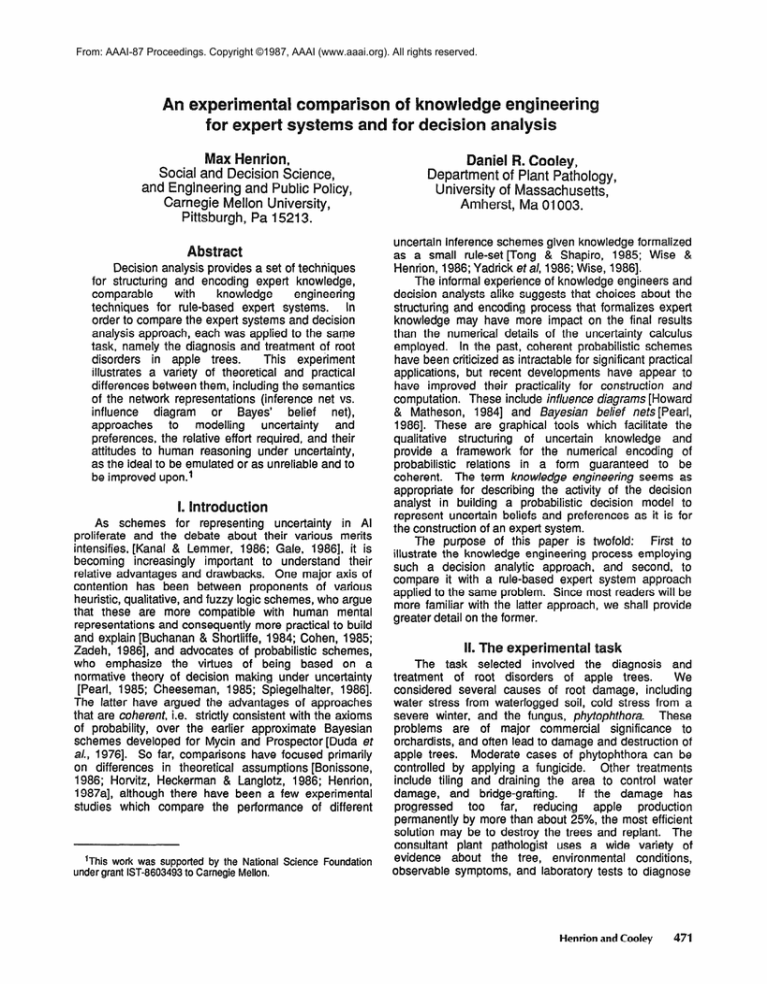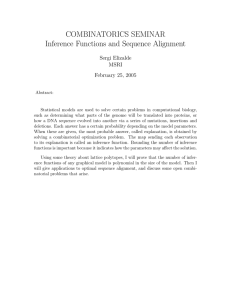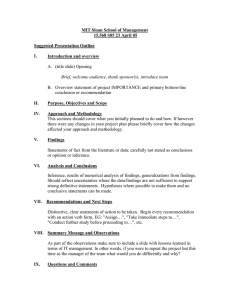
From: AAAI-87 Proceedings. Copyright ©1987, AAAI (www.aaai.org). All rights reserved.
enrion,
cision Science,
and Engineering and Public Policy,
Carnegie Mellon University,
Pittsburgh, Pa 15213.
straea
provides a set of techniques
for structuring and encoding expert knowledge,
with
comparable
knowledge
engineering
techniques for rule-based expert systems.
In
order to compare the expert systems and decision
analysis approach, each was applied to the same
task, namely the diagnosis and treatment of root
disorders in apple trees.
This experiment
illustrates a variety of theoretical and practical
differences between them, including the semantics
of the network representations (inference net vs.
influence
diagram
or Bayes’ belief
net),
approaches
to
modelling
uncertainty
and
preferences, the relative effort required, and their
attitudes to human reasoning under uncertainty,
as the ideal to be emulated or as unreliable and to
be improved upon?
As schemes for representing uncertainty in Al
proliferate and the debate about their various merits
intensifies, [Kanal & Lemmer, 1986; Gale, 19861, it is
becoming increasingly important to understand their
relative advantages and drawbacks. One major axis of
contention has been between proponents of various
heuristic, qualitative, and fuzzy logic schemes, who argue
that these are more compatible with human mental
representations and consequently more practical to build
and explain [Buchanan & Shortliffe, 1984; Cohen, 1985;
Zadeh, 49861, and advocates of probabilistic schemes,
who emphasize the virtues of being based on a
normative theory of decision making under uncertainty
[Pearl, 1985; Cheeseman, 1985; Spiegelhalter, 19861.
The latter have argued the advantages of approaches
that are coherent, i.e. strictly consistent with the axioms
of probability, over the earlier approximate Bayesian
schemes developed for Mycin and Prospector [Duda et
a/., 19761. So far, comparisons have focused primarily
on differences in theoretical assumptions [Bonissone,
1986; Horvitz, Heckerman & Langlotz, 1986; Henrion,
1987a], although there have been a few experimental
studies which compare the performance of different
‘This work was supported by the National Science Foundation
under grant ET-8603493 to Carnegie Mellon.
uncertain inference schemes given knowledge formalized
as a small rule-set [Tong & Shapiro, 1985; Wise &
Henrion, 1986; Vadrick et al, 1986; Wise, 19861.
The informal experience of knowledge engineers and
decision analysts alike suggests that choices about the
structuring and encoding process that formalizes expert
knowledge may have more impact on the final results
than the numerical details of the uncertainty calculus
employed. In the past, coherent probabilistic schemes
have been criticized as intractable for significant practical
applications, but recent developments have appear to
have improved their practicality for construction and
computation. These include influence diagrams [Howard
& Matheson, 19841 and Bayesian belief nets [Pearl,
19861. These are graphical tools which facilitate the
qualitative structuring of uncertain knowledge and
provide a framework for the numerical encoding of
probabilistic relations in a form guaranteed to be
coherent. The term knowledge engineering seems as
appropriate for describing the activity of the decision
analyst in building a probabilistic decision model to
represent uncertain beliefs and preferences as it is for
the construction of an expert system.
The purpose of this paper is twofold:
First to
illustrate the knowledge engineering process employing
such a decision analytic approach, and second, to
compare it with a rule-based expert system approach
applied to the same problem. Since most readers will be
more familiar with the latter approach, we shall provide
greater detail on the former.
The task selected involved the diagnosis and
treatment of root disorders of apple trees.
We
considered several causes of root damage, including
water stress from waterlogged soil, cold stress from a
severe winter, and the fungus, phytophthora.
These
problems are of major commercial significance to
orchardists, and often lead to damage and destruction of
apple trees. Moderate cases of phytophthora can be
Other treatments
controlled by applying a fungicide.
include tiling and draining the area to control water
damage, and bridge-grafting.
If the damage has
progressed
too
far,
reducing
apple
production
permanently by more than about 25%, the most efficient
solution may be to destroy the trees and replant. The
consultant plant pathologist uses a wide variety of
evidence about the tree, environmental conditions,
observable symptoms, and laboratory tests to diagnose
Henrion and Cooley
471
the cause
treatments.
problem.
of root damage, and so recommend
Figure 1 lists some of the elements of the
iagnoses: Phytophthora, cold stress, water stress.
reatments: Fungicide, tiling and drainage, uproot and
replant, wait and see.
Exaiqdes of evidential wariables (with values):
Winter cold episodes without snow cover
(yes, no)
e Soil texture (light, moderate, heavy)
8 Wetland vegetation (yes, no)
0 Phytophthera resistant root stock (yes, no)
0 Delineated root cankers (yes, no)
8 Root tissue damage (None, little, moderate,
severe)
Figure 1: Selected elements of the apple root problem
Two decision support systems were constructed to
diagnose root disorders in apple trees and recommend
treatment. One, which we will term the “ES model”, was
built by an knowledge engineer experienced in building
knowledge-based expert systems. The other, which we
will term the “DA model”, was built by an experienced
decision analyst. Both were developed on the basis of
extensive interviews with a plant pathologist (D.R.C.),
who has ten years experience as a specialist in this area.
The initial structuring, encoding and implementation
phases of the knowledge engineering process were
carried out over an intensive four-day period, during
which the two knowledge engineers alternated in working
with the expert. The full implementation, testing, and
refinement of the systems were completed over a longer
time frame.
The ES model was implemented in KEE (Intellicorp)
as a standard inference network with data-directed
control.
Diagnostic relationships are represented as
rules giving the degree of belief in intermediate
hypotheses
and
disorders
based
on
Boolean
combinations of data (evidential variables). Additional
rules provide support for various treatments based on the
diagnoses and other evidence.
The DA model employs an influence diagram to
represent the expert’s beliefs about how possible root
disorders
and treatments
might affect the tree
productivity and costs. It incorporates a Bayesian belief
net to diagnose the disorders based on the available
evidence. During the initial interview period, part of the
influence diagram was used to construct a decision tree,
which was implemented in Arborist (Texas Instruments)
Subsequently, the entire
for preliminary analysis.
influence diagram including the diagnostic belief net was
implemented using a combination of algorithms for
propagating evidence through Bayes’ nets [Pearl, 1986;
Henrion, 1987b].
472
Machine Learning & Knowledge Acquisition
The initial phase for both approaches was to identify
the objects in the domain, that is, the root disorders,
treatments, and evidential variables.
Both knowledge
engineers worked with the expert to draw directed graphs
which represent qualitative evidential links between these
elements. The first to be acquired was the influence
From this, and further
diagram for the DA model.
discussion with the expert, an inference net was derived.
These networks allow the decomposition of the expert’s
domain knowledge into separable local relationships.
The initial influence diagram had 30 nodes, and the
inference net had 25, of which 20 were common to both.
Figure 2 shows a fragment of both networks
superimposed for comparison.
Although they are topologically similar, there is a
fundamental difference in the interpretation of the links.
In the inference net, the direction of the links corresponds
to the anticipated direction of inference, from evidence to
disorders to treatments.
In the influence diagram the
direction of the links generally represents the believed
direction of causal influence, for example abiotic stress
increases susceptibility to phytophthora, and either of
these can cause root tissue damage.
Note that the
influence diagram does not need to represent causal
influences in full scientific detail (e.g. the physiology of
how phytophthora produces root tissue damage) even
when this is known, unless it seems likely to significantly
improve the inference results. The influence diagram is
also a way to express qualitative judgments about
probabilistic independence: Two unlinked variables with a
common cause (e.g. the phytopthora lab test and root
tissue damage) are conditionally independent of each
other and also of indirect antecedents (e.g. resistant root
stock) given their immediate cause (e.g. phytophthora
Figure 2: Fragment of influence diagram (solid arrows)
with corresponding inference network (hatched arrows)
infection).
As Figure 2 shows, the links in the two
representations may go in the same direction, such as
where resistant root stock decreases susceptiblity to
phytophthora infection and (therefore) provides evidence
More often they go in opposite
against phytophthora.
directions, such as where observable symptoms are
caused by a disease and therefore they are used as
evidence for it. For example, phytophthora can cause
delineated cankers, and so cankers are evidence for
phytophthora.
For both approaches, the directed links help in the
subsequent encoding of the relationships. For the ES
approach, arrows converging on a node indicate a
potential diagnostic rule with the antecedent nodes to
appear in the condition and the destination node to
appear in the action. For the DA approach, uncertain
influences are encoded as conditional distributions with
the antecedent nodes as the conditioning variables.
Psychological research suggests it is generally easier to
assess the probabilities of effects conditional on their
causes (e.g. symptoms given diseases) than vice versa
[Kahneman, Slavic & Tversky, 19821,
This ES model, like almost all rule-based expert
systems, can only propagate evidence in the direction in
which it is encoded, (no matter whether the inference is
controlled by forward or backward chaining.) In contrast,
in the DA model the influence diagram does not
By taking
determine the direction of inference.
expectations over the conditions, this may be in the
causal direction, or, by application of Bayes’ rule, it may
be the opposite, diagnostic direction, according to
requirements of the application.
For example, it is
possible to determine the current probability of an
unexamined symptom, based on observations of other
symptoms, before deciding whether it is likely to be
worthwhile to examine it.
the orchardist was assumed to be risk neutral. The DA
model computes the expected net cost of each treatment
and recommends the treatment which minimizes it.
The ES model relies on heuristic rules for making
inferences about what treatments to recommend based
on the degrees of belief in the diagnoses without explicit
consideration of costs. This approach seemed more
natural for the expert, and was certainly much easier.
Since the costs of treatment, tree replacement, and lost
production for a given outcome do not vary greatly from
one orchard to another, one can argue that such general
rules may be widely applicable, somewhat analogous to
the way it has been suggested that Mycin rules might be
justified by decision analysis [Langlotz, Shortliffe, &
Fagan, 19861. However, as we shall see, at least in this
case, formal analysis raises doubts about the adequacy
of such informal analysis.
s
In the ES model, the relationships in the inference
network were encoded as sets of rules. The “degree of
belief” in a hypothesis is one from the following ordered
set of seven values: {confirmed, strongly-supported,
supported,
neutral,
detracted,
strongly-detracted,
disconfirmed}. Each rule specifies the degree of belief in
a conclusion based on combinations of its antecedents.
For example, the rules in Figure 4 specify the degree of
belief in phytophthora damage based on the values of six
possible sources of evidence. These rules encode only
those combinations of evidence thought by the expert to
be important.
if phyto-resistance is low then supported
if reduced-fine-root-hairs is yes then supported
if reduced-fine-root-hairs is no then detracted
if cold-stress is at least supported or
water-stress is at least supported then supported
if tissue-discoloration-below-soil is delineated-canker or
tissue-discoloration-above-soil is delineated-canker
then strongly-supported
Figure 4: Example diagnostic rules from the ES
model for level of belief in phytophthora infection
Figure : Influence diagram showing relation between
root problems, treatment and outcome costs. The
decision is enclosed in a rectangle, and the
criterion variable is enclosed in a diamond.
ellin
sts at-i
references
The DA approach developed an explicit quantitative
model to estimate the costs and values of each
combination of outcomes and treatments (Figure 3).
Costs over multiple years were combined to obtain a
discounted present value (a replacement tree takes 5
years to achieve full production). For the initial model,
Each uncertain influence is encoded as a probability
distribution for the consequent, conditional on all its
antecedents. To quantify each distribution, the expert
was first asked for a verbal expression to get a rough
idea, and then for explicit numbers.
For example,
evidence PI, wetland vegetation, was judged to be
causally influenced by hypothe ’
wet site. The expert
judged it “quite probable” that
nd vegetation would
be observed at a wet site, “impossible” if it was not a wet
site. These judgments w re then quantified as the two
conditional probabilities,
04 w = 0.7, p(wI-w) = 0.
Sensitivity analysis was used to examine the importance
of accuracy in such assessments. In the vast majority of
cases, a very rough assessment is perfectly adequate.
Henrion and Cooley
473
Fungicide
treatment
Abiotic
stress
Phytoph.
infection
Damage
to tree
None
None
1
None
Temporary
Permanent
0.2
0.5
0.3
Replace
1
None
0.25
Temporary
Permanent
Reolace
0.35
0.35
0.2
None
Conditional
probability
I
I
Treat
I
Nonrecov
explicitly, and so requires more extensive testing and
refinement.
The two approaches differ fundamentally in their
response to unexpected results. For the ES model, rules
were modified or added to obtain results that agreed
more closely with the original expectations of the expert,
since the primary goal was to emulate his judgment. In
the DA approach, after initial rechecking of the relevant
the
model structure and assessed probabilities,
leading to the surprising
probabilistic
reasoning
conclusions was explained to the expert. If this lead him
to accept them, the system was left unmodified. This
was clearly illustrated by the following example.
Preliminary sensitivity analysis of the decision tree in
Figure 5 showed that treating with fungicide had positive
expected value, since the treatment is cheap (about
$0.58 per tree) relative to the cost of replacing a tree
(about $85). But the actual increment in expected value
turned out to be very small, so small that it might often be
outweighed by considerations not explicit in the model,
such as environmental side-effects of the fungicide. This
result was initially surprising to the expert, but
examination of the model provided an explanation: The
fungicide’s effectiveness in controlling phytophthora was
judged to be modest, and the probability that a tree is
curable, i.e. that an infection is both present and not
already beyond recovery is quite low. On reflection, he
found this explanation convincing, and the result likely to
be of considerable practical interest.
Figure 5: Partial decision tree for treatment decision
The number of parameters of the conditional
distribution increases exponentially with the number of
conditioning variables, but qualitative knowledge can
usually reduce the assessment effort drastically.
For
example, the damage to the tree has 4 levels,
conditioned on the severity of the phytophthora infection
and abiotic stress, each at 3 levels, and the fungicide
treatment decision (yes or no), giving a potential of 4 x 3
x3x2
= 72 parameters to be judged. However, ,many
Iare impossible, certain, or otherwise constrained by
qualitative considerations, and there are actually only 12
different numbers requiring assessment. Figure 5 shows
half of the decision tree whose terminal branches
represent this conditional distribution.
VU. Testing and Refinement
In both approaches, initial implementations were
tested to see if their conclusions were reasonable in the
judgment of the expert, and the models were elaborated
During the
and tuned in the light of these tests.
construction of the DA model, the use of conditional
distributions to encode influences requires the expert to
consider the impact of all possible combinations of
The
evidence and decisions for each influence.
approach to encoding diagnostic rules for the ES model
was much less demanding in its initial requirements of
the expert. But it is consequently more likely to encounter
combinations of events that had not been considered
474
Machine Learning & Knowledge Acquisition
No single knowledge engineer or decision analyst
claim
can
that
their
approach
is completely
representative of all practitioners of their respective
crafts. Certain aspects of both the approaches used here
are somewhat atypical. The qualitative representation of
uncertainty used in the ES model is less common than
heuristic numerical schemes, such as Certainty Factors.
The particular techniques applied here for evaluating
influence diagrams are recent and not yet in general use.
The size of both models and the effort devoted to their
construction were quite modest. Nevertheless, several
important points of comparison which are of general
applicability to the two approaches, are clearly illustrated
by this experiment.
In the initial structuring phase there are significant
similarities between the approaches in the identification
of the key elements, and the use of graphs to represent
their interrelationships, but it is important to understand
the fundamental differences in meaning between the
inference network and influence diagram. Of course,
research in expert systems has developed a rich array of
techniques for knowledge represention and categorical
reasoning that have not been a formal concern of
decision analysis. It is specifically in the approaches to
inference under uncertainty and decision making that the
comparison is interesting. Here the main advantage of
the ES approach is in the greater ease in initially
encoding uncertain dependencies. This arises from the
informal, heuristic nature of the language whether
qualitative (as in this experiment) or quantitative, and the
willingness to accept partial specifications, with inference
rules conditioned on only the most salient combinations
of evidence rather than the exhaustive combinations
required for the DA model. The greater ease of encoding
means that, for a given expenditure of effort, it is possible
to build a system that deals with a larger number of
sources of evidence, diagnoses and treatments than with
the more rigorous DA approach.
The downside of this more relaxed approach is that
the ES model is likely to require more extensive testing,
debugging, and tuning to ensure that it performs
adequately, and can handle common and impoflant
situations. Whether this additional effort will, in general,
entirely cancel out its initial advantage is unclear from a
single experiment and will depend on the criterion for
adequacy.
Many in the Al community have believed coherent
probabilistic approaches to be essentially intractable for
problems involving the explicit representation of large
bodies of expert knowledge. Part of this belief may stem
from the traditional decision tree representation used by
decision analysts, which grows exponentially with the
number of uncertain events and decision variables.
However, as illustrated, the influence diagram and Bayes’
belief net provide tools for structuring and probabilistic
inference which, if used judiciously, may have only linear
complexity, albeit with a higher constant than the ES
approach. A second common misgiving about the DA
approach is the quantity of numerical judgments needed
for assessing the probabilities. As we have seen, this
may be greatly reduced by careful structuring and use of
qualitative knowledge. Moreover, the vast majority of the
numbers have small impact on the results, and so rough
judgments will be adequate. Sensitivity analysis can help
identify those few where significant assessment effort
may be worthwhile.
Many of the advantages of the DA approach arise
from its clearer separation of domain knowledge,
obtained from the expert, and its general methods for
inference under uncertainty based on 5ayesian decision
theory. The modelling of causal influences instead of
inference rules provides an isotropic representation of
domain knowledge with no preferred direction of
inference [Henrion, 1987a]. Where the ES rules support
inference only in the direction encoded, coherent
Bayesian inference can perform causal, or diagnostic
inference, as the occasion demands, operating on the
same representation. The fact that causal models turn
out to have advantages in representing uncertainty
suggests an interesting relationship with other work on
causal modelling for explanation
and categorical
diagnosis, for example in medical Al [Patil & Szolovits,
19811.
The treatment of discrepancies
between the
conclusions of the model and the expert illustrates a
basic difference in philosophy. In the ES approach the
performance of the expert is considered the ‘“gold
standard” which we seek to emulate. Discrepancies are
therefore taken as a sign of a deficiency, and must be
remedied by modifying or adding inference rules. The
decision analyst also relies on the judgment of the expert,
at least in those areas for which the expert has direct
experience or knowledge. However, the decision analyst
tends to be more impressed by the psychological findings
on the limitations of human reasoning under uncertainty
[Kahneman, Slavic & Tversky, 19821, and so is more
skeptical about the expert’s inferences beyond his
If they disagree with the
immediate experience.
inferences made by the model, then the decision analyst
may well prefer the results of the model. Indeed the
possibility that the formal model may improve on the
intuitive inferences of the expert is a major motivation for
constructing it.
This was dramatically illustrated in the experiment by
the low expected value of the fungicide treatment which
the expert initially found counter-intuitive.
After
rechecking the assumptions and understanding the
reasoning, he accepted its validity and modified his
intuition. He found this an important insight likely to be of
general value to other specialists in the area. The
possibility of obtaining new results which go beyond
current expert opinion requires a basis in some normative
theory of decision making. Since the expert’s original
belief about the worth of the fungicide treatment was
consistent with current opinion, and not liable to obvious
empirical contradiction, such an insight would be hard to
obtain by informal means.
R
RUSi
We have argued that the knowledge engineering
effort required for a decision analytic approach is less
than widely believed, and have demonstrated its
feasibility for a significant application. However, although
the influence diagram developed here is perhaps the
largest yet reported, it remains two orders of magnitude
smaller in scope than the largest expert systems reported
(e.g. InternistXaduceus), and it would be premature to
make general claims about its capacity for major scaleUP. Although decision analysis has been practiced
successfully for over fifteen years, software to support
influence diagram structuring and evaluation is still its
infancy, though developing
rapidly [Wiecha, 1986;
Holtzman, 1985; Shachter, 1986; Henrion, 1987b]. The
knowledge engineering effort for the decision analytic
approach, will no doubt be significantly reduced, although
is likely to remain somewhat greater than for rule-based
expert systems.
However, there are considerable advantages to
methods based on normative theory.
It facilitates a
consistent integration of causal and diagnostic inference.
Uncertain
beliefs
and
preferences
are
clearly
differentiated. It provides a cleaner separation between
domain knowledge and inference methods, and so may
improve on the fallible reasoning of the expert. Whether
these advantages outweigh the extra effort involved
depends on the problem domain and task, and will
remain partly a matter of taste. In the future, the dilemma
may be resolved by systems that integrate ideas and
techniques from both approaches to provide a richer
range of options combining the advantages of each.
Wenrion and Cooley
References
. Bonissone, P. P. (1986). Plausible Reasoning: Coping
with Uncertainty in Expert Systems. In Encyclopedia
of/l/. John Wiley & Sons.
Patil, R.S. & Szolovits, P. (1981). Causal understanding
of patient illness in medical diagnosis. Proceedings
of IJCAI-87: Vancouver, Canada. , International-Joint
Committe for Al.
Buchanan, B. G. & Shortliffe, E. H. (1984). Rule-based
Expert Systems: The MYCIN Experiments of the
Stanford Heuristic Programming Project. AddisonWesley, Reading, Mass.
Pearl, J. (1985). How to do with probabilities what
people say you can’t (Tech. Rep. CSD-850031).
Cognitive Systems Laboratory, Computer Science
Department, University of California, Los Angeles,
CA.
Cheeseman, P.
(1985). In Defense of Probability.
Proceedings of 9th International Joint Conference on
Al. Los Angeles, Ca.
Pearl, J. ( 1986). Fusion, Propagation, and Structuring
in Belief Networks. Artificial Intelligence, 29(3),
241-288.
Cohen, P.R.
(1985). Heuristic Reasoning
Uncertainty: An A/ Approach. Pitman: Boston.
(1986). David: Influence Diagram
Shachter, R.D.
In
Processing
System for the Macintosh.
Proceedings of Second Workshop on Uncertainty in
Artificial Intelligence. AAAI.
about
Duda, R. O., Hart, P. E., and Nilsson, N. J. (1976).
Methods for Rule-Based
Subjective
Bayesian
Inference Systems (Tech. Rep. SRI Technical Note
124). SRI International.
Gale, W. A. (ed.). (1986). A/ and Statistics.
Wesley: Reading, MA.
Addison-
Henrion, M. (1987). Uncertainty in Artificial Intelligence:
Is probability epistemologically
and heuristically
adequate? In J. Mumpower (Ed.), Expert Systems
and Expert Judgment. NATO ISI Series: SpringerVerlag.
Henrion, M (1987). Propagation of Uncertainty by Logic
Sampling in Bayes’ Networks.
In L.N. Kanal &
4. Lemmer (Eds.), Uncertainty in Artificia/ Intelligence.
Amsterdam: North-Holland.
Holtzman, S.
(1985). Intelligent Decision Systems.
Doctoral
dissertation,
Engineering-Economic
.Systems, Stanford University,
Horvitz, E.J., D.E. Heckerman & C.P. Langlotz. (1986). A
framework for comparing alternative formalisms for
plausible reasoning.
Proceedings of AAAI-86:
American Association for
Philadelphia, PA.
Artificial Intelligence.
Howard, R.A. & J. E. Matheson.
(1984). Influence
Diagrams. In Howard, R.A. & J. E. Matheson (Eds.),
The Principles and Applications of Decision Analysis:
vol /I. Strategic Decisions Group, Menlo Park, CA.
Kahneman, D.; Slavic, P. & Tversky, A.
(1982).
Judgment under Uncertainty: Heuristics and Biases.
Cambridge: Cambridge University Press.
Kanal, L.N. & Lemmer, J. (eds.). (1986). Uncertainty in
Artificial Intelligence. North-Holland: Amsterdam.
Langlotz, C.P., E.H. Shortliffe, & L.M. Fagan. (1986).
Using
decision
theory
to justify
heuristics.
American Association for
Proceedings of AAAI-86.
Artificial Intelligence.
476
Machine Learning & Knowledge Acquisition
(1986). A statistical view of
Spiegelhalter, D. J.
uncertainty in expert systems. In W. Gale (Eds.), Al
and Statistics. Addison-Wesley: Reading, MA.
Tong, R. M., Shapiro, D. G. (1985).
Experimental
Investigations of Uncertainty in a Rule-based System
for Information Retrieval. international Journal of
Man-Machine Studies .
Wiecha, C. (1986). An empirical study of how visua:
programming aids in comprehending quantitative
Doctoral dissertation, Carnegie
policy models.
Mellon University, Department of Engineering and
Public Policy,
Wise, B.P.
(1986). An experimental comparison of
Uncertain Inference Systems. Doctoral dissertation,
Carnegie Mellon University, The Robotics Institute
and Department of Engineering and Public Policy,
Wise, B.P. & Henrion, M. (1986). A Framework for
Comparing
Uncertain
Inference
Systems
to
Probability.
In Kanal, L.N. & Lemmer, J. (Eds.),
Uncertainty in Artificial Intelligence. North-Holland:
Amsterdam.
Yadrick, R. M., Vaughan, D. S., Perrin, B. M., Holden,
P. D., Kempf, K. G. (1986). Evaluation of Uncertain
Inference Models I: PROSPECTOR.
In Second
Workshop on Uncertainty in Al. AAAI.
Zadeh, L. (1986). Is probability theory sufficient for
dealing with uncertainty in Al? A negative view. In
L.N. Kanal & J. Lemmer (Eds.), Uncertainty in
Artificial Intelligence. Amsterdam: North-Holland.





